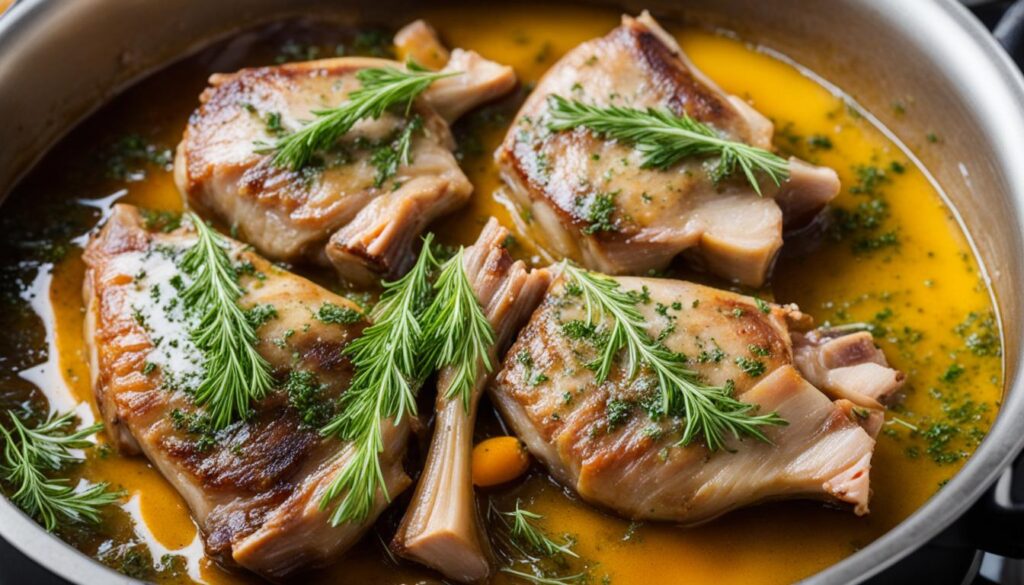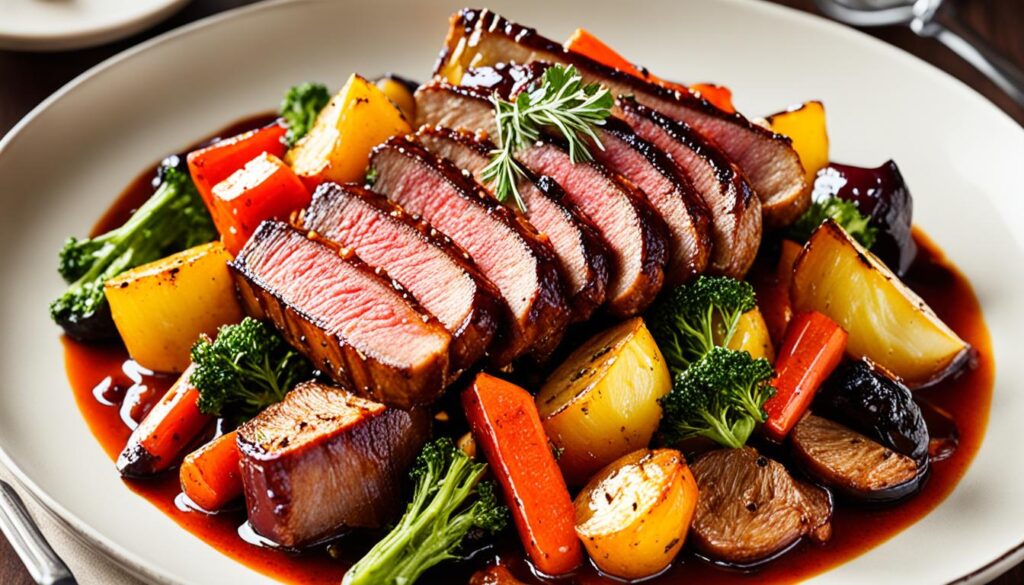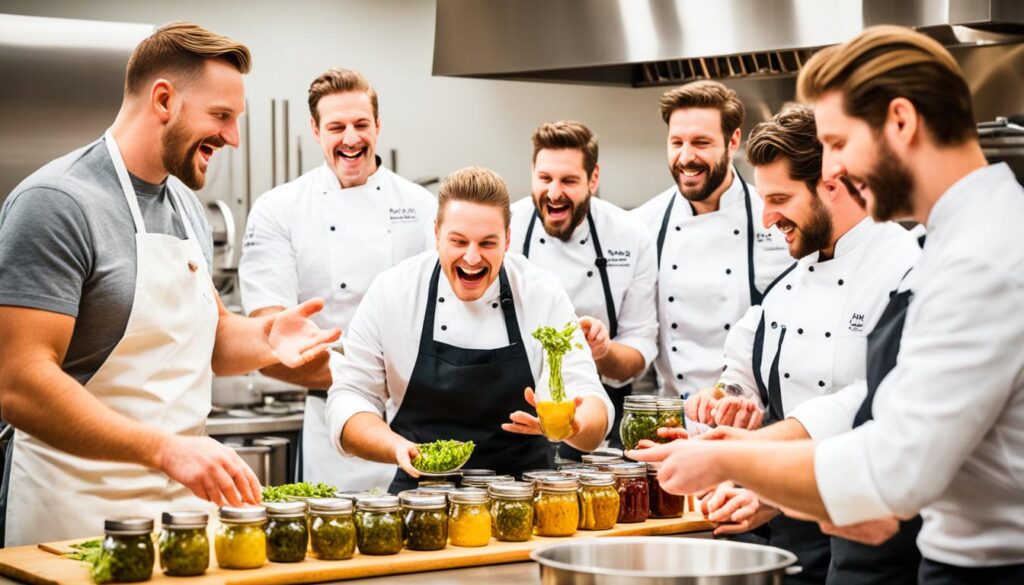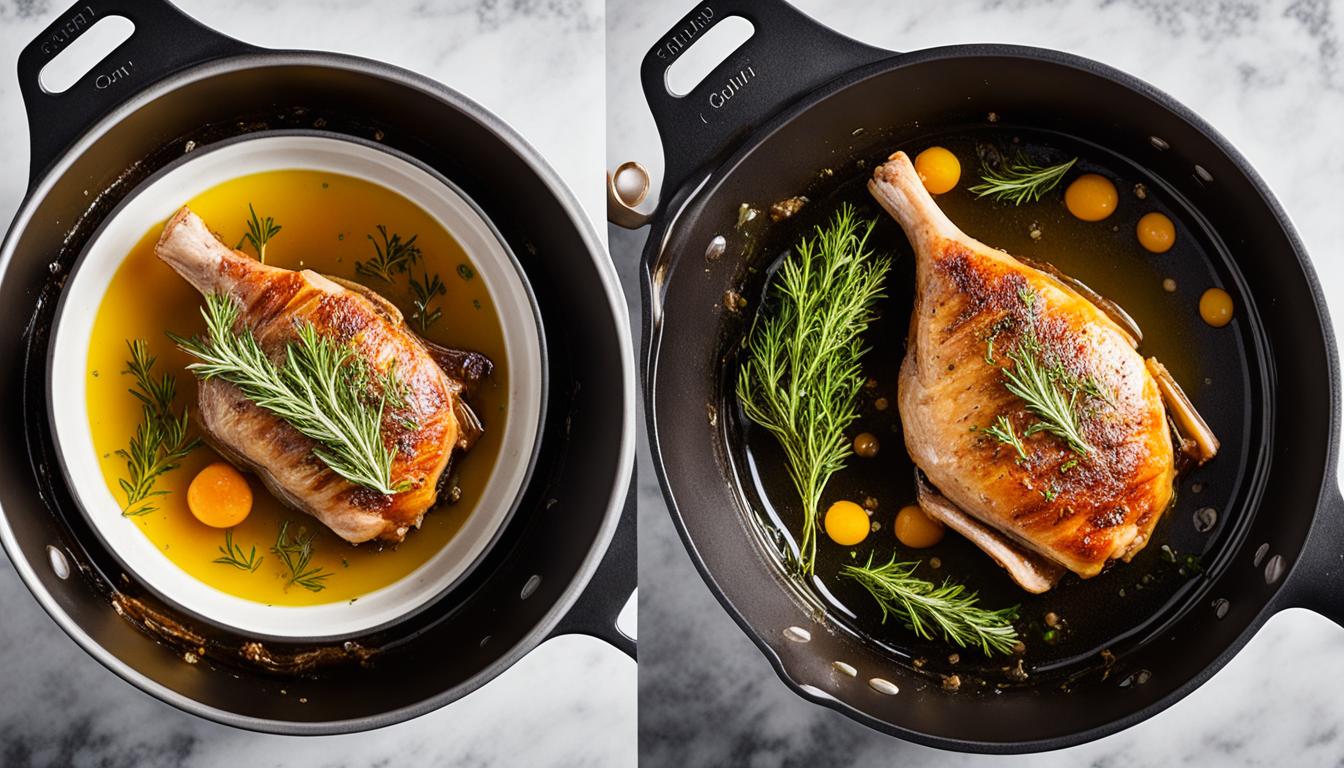Welcome to The Food Lab, where we unravel culinary mysteries and explore the fascinating world of gastronomy. Today, we dive into the enigmatic realm of confit. What the heck is confit? How is it made? What does it mean in the culinary world? Join us as we demystify this ancient preservation method and uncover the secrets of confit’s culinary practice.
Confit has a long and storied history, originating in medieval France as a way to preserve meat before refrigeration was available. Through slow-cooking in its own fat, confit transforms tough cuts of meat into tender, succulent delicacies. The result is a preservation method that not only extends the shelf life of the meat but also infuses it with rich and complex flavors.
In this article, we will delve into the definition and cooking technique of confit, explore a classic confit recipe, discuss its significance in culinary practice, and unravel the preservation method behind this ancient culinary tradition. Whether you’re a food enthusiast or a professional chef, prepare to expand your knowledge and culinary repertoire as we uncover the wonders of confit.
Key Takeaways:
- Confit is a traditional French cooking technique that involves slow-cooking meat in its own fat.
- The term “confit” means to preserve, and the method was developed as a means of meat preservation before refrigeration.
- Confit results in tender, flavorful meat that can be enjoyed hot or cold in a variety of dishes.
- The slow cooking process infuses the meat with the flavors of the fat and herbs, creating a rich and succulent dish.
- Confit is not limited to meat; it can also be used with vegetables, fish, and fruits to create unique and flavorful dishes.
What Is Confit?
Confit refers to a traditional French cooking technique that involves preserving meat, typically poultry or game, by slow-cooking it in its own fat. The term “confit” comes from the French word “confire,” which means to preserve. The meat is cooked at a low temperature for an extended period, resulting in tender, flavorful, and preserved meat.
| Key Characteristics of Confit | Benefits of Confit |
|---|---|
|
|
The History of Confit
The practice of confit can be traced back to medieval times in France. It was originally developed as a way to preserve meat before the advent of refrigeration. Farmers would cook and store meat in pots filled with fat to keep it fresh for an extended period. Over time, confit became a culinary tradition in French cuisine and is still highly regarded today.
The Confit Cooking Technique
To make confit, we begin by seasoning the meat with a generous amount of salt and aromatic herbs. This step is crucial as it helps to enhance the flavor profile of the final dish. Traditional herbs such as thyme, rosemary, and bay leaves work exceptionally well.
Once the meat is seasoned, it is time to embark on the slow and gentle cooking process that defines the confit technique. The meat is submerged in a bath of fat, typically duck or goose fat, which acts as both a cooking medium and a preservation agent.
The fat provides a protective barrier that seals in the natural juices of the meat, resulting in a tender and succulent texture. Additionally, the slow cooking process at a low temperature between 200-225 degrees Fahrenheit allows the flavors to meld together, resulting in a rich and savory dish.
During the cooking process, it is essential to monitor the temperature and cooking time carefully. The meat should be cooked for several hours until it becomes tender and easily falls off the bone. This slow cooking process allows the meat to fully develop its flavors, resulting in a truly satisfying culinary experience.
The confit cooking technique can be applied to a variety of meats, including poultry, game, and even fish. Each type of meat offers its unique flavors and textures when prepared in this method, allowing for endless possibilities and culinary creativity.
“The confit cooking technique is a true testament to the artistry and patience required in the culinary world. Slowly transforming tough cuts of meat into tender delicacies, confit offers a flavor experience like no other.”
Whether you are a seasoned chef or a home cook looking to elevate your culinary skills, mastering the confit cooking technique opens up a world of delicious possibilities. The combination of tender meat and infused flavors makes confit a standout dish that never fails to impress.
A Classic Confit Recipe
Here is a classic recipe for making confit:
- Season the meat with salt, pepper, and your choice of herbs, such as thyme or rosemary.
- Place the seasoned meat in a container and cover it with the desired fat, ensuring that the meat is fully submerged.
- Slow-cook the meat in the fat at a low temperature, usually in an oven, for several hours until it becomes tender and falls off the bone.
- Once cooked, remove the meat from the fat and allow it to cool slightly.
- Serve the confit meat as desired, either hot or cold, with accompaniments such as potatoes or vegetables.
Cooking Time and Temperature for Different Meats
| Meat | Cooking Time | Cooking Temperature |
|---|---|---|
| Duck Legs | 4-6 hours | 200°F (93°C) |
| Goose Legs | 6-8 hours | 200°F (93°C) |
| Chicken Legs | 2-3 hours | 185°F (85°C) |
“Confit is a labor of love – a slow and careful process that yields incredible flavor and tenderness.” – Chef Jean-Pierre
Confit, a traditional French culinary technique, involves slow-cooking meat in fat until it becomes tender and falls off the bone. The process ensures the preservation and enhancement of flavors, resulting in a delectable dish with a rich taste profile. Whether you’re indulging in duck legs, goose legs, or chicken legs, the cooking time and temperature vary for each meat. Here’s a table outlining the appropriate cooking parameters:
The Significance of Confit in Culinary Practice
Confit holds immense significance in the culinary world, as it has the power to elevate tough cuts of meat into tantalizingly tender and flavorful delicacies. The slow cooking process employed in confit allows the meat to become infused with the rich flavors of the fat and herbs, resulting in a truly exquisite dish.
- Confit enhances the taste and texture of meat, creating a melt-in-your-mouth experience that delights the palate.
- The flavors of the fat and herbs permeate the meat, imparting a distinct, savory character that cannot be replicated by other cooking methods.
- The slow cooking process gently breaks down the collagen and connective tissues, resulting in meat that is incredibly tender and succulent.
- Confit adds depth and complexity to various dishes, turning them into culinary masterpieces. It can be used as a technique to enhance the flavors of salads, sandwiches, and hearty cassoulets.
Confit is a testament to the artistry and expertise of chefs, who harness the transformative power of slow cooking to create exceptional dishes that impress and delight diners.

“Confit enhances the taste and texture of meat, creating a melt-in-your-mouth experience that delights the palate.”
The Preservation Method of Confit
When it comes to confit, its preservation method is as fascinating as its flavor. The slow cooking process and the use of fat contribute to the preservation of meat in this traditional French technique.
During the slow cooking at a low temperature, the collagen and connective tissues in the meat break down, resulting in a tender texture that effortlessly falls off the bone. This slow and gentle process not only enhances the taste and tenderness of the meat but also aids in its preservation.
The fat used in confit acts as a natural preservative by creating a seal that prevents spoilage and extends the shelf life of the preserved meat. This seal, formed by the slow-cooked meat being submerged in fat, effectively protects the meat from bacteria and other external factors that could cause deterioration.
By combining the transformative power of slow cooking with the preservative properties of fat, confit succeeds in preserving meat while infusing it with rich flavors and maintaining its succulence.
The Science Behind Confit Preservation
Confit’s preservation method relies on the principles of slow cooking and the antimicrobial properties of fat. The breakdown of collagen and connective tissues during the slow cooking process not only tenderizes the meat but also inhibits the growth of bacteria and microorganisms that lead to spoilage.
The high fat content in confit further contributes to its preservation. The fat forms a protective layer around the meat, acting as a barrier against oxygen and preventing bacterial growth, thus allowing the preserved meat to be stored for an extended period.
The combination of slow cooking and fat preservation in confit showcases the ingenuity of traditional culinary techniques in preserving and enhancing the flavors of meat.
Preservation Without Compromising Flavor
One of the remarkable aspects of confit preservation is that, unlike other preservation methods, it doesn’t compromise the flavor or quality of the meat. While preserving the meat, the slow cooking process imparts deep, rich flavors and creates a tender and succulent texture.
The infusion of flavors from the fat, herbs, and seasonings used during the cooking process adds depth and complexity to the preserved meat. This results in a preserved delicacy that not only remains fresh and safe to consume but also retains its original taste and texture.
Modern Interpretations of Confit
While traditional confit typically involves preserving poultry or game meat, modern interpretations have expanded to include a wide range of ingredients. Chefs now use the confit technique to prepare vegetables, fish, and even fruits. The cooking process and use of fat remain the same, resulting in unique and flavorful dishes that showcase the versatility of the confit technique.

Contemporary confit variations offer exciting alternatives to traditional meat-focused preparations. Chefs experiment with different ingredients to create dishes that cater to various dietary preferences and culinary sensibilities. From vibrant vegetable confits to delicate fish confit preparations, these modern interpretations captivate both the palate and the eye.
Expanding the Boundaries of Confit
One of the most intriguing aspects of contemporary confit is its ability to transform seemingly ordinary ingredients into extraordinary culinary delights. By slow-cooking ingredients in fat, distinct flavors are infused, and textures become tender and succulent. Modern chefs push the boundaries of confit, exploring new combinations and bringing innovation to the table.
Vegetable confits, for example, offer a delightful twist to traditional confit dishes. Artichoke hearts, carrots, and eggplant are just a few examples of vegetables that can be transformed into mouthwatering confit creations. These vegetable confits can be enjoyed as a standalone dish or incorporated into various recipes, adding depth and complexity.
“Modern interpretations of confit have allowed us to explore the incredible capabilities of this traditional cooking technique. By embracing a wider array of ingredients, we have unlocked a world of flavors and possibilities, making confit more exciting and accessible than ever before.”
– Chef Emily Thompson, Le Petit Bistro
The Artistry of Modern Confit Dishes
Modern confit dishes not only capture the essence of their traditional counterparts but also showcase the creativity and artistry of contemporary chefs. The careful balance of flavors, textures, and presentation elevates confit to new heights.
Fish confit, for instance, is a popular choice among seafood enthusiasts. By gently cooking fish fillets in aromatic oil or butter, the delicate nature of the fish is preserved, resulting in tender and flaky pieces. Paired with vibrant herb-infused oils or tangy citrus reductions, these modern fish confit dishes are a feast for the senses.
Fruit Confit: A Sweet Revelation
Another captivating variation of modern confit is fruit confit, where fruits such as apples, pears, or citrus are slowly cooked in syrup or honey to create tender, caramelized treats. The natural sweetness of the fruits intensifies, creating a luscious and decadent dessert or accompaniment to savory dishes. Paired with a dollop of whipped cream or a drizzle of balsamic reduction, fruit confit offers a delightful balance of flavors.
Contemporary confit variations and modern confit dishes breathe new life into this traditional French cooking technique. Through the innovative use of ingredients and the imagination of talented chefs, the boundaries of confit continue to be pushed, resulting in culinary creations that tantalize the taste buds and celebrate the art of cooking.
Popular Confit Dishes
Confit is a versatile culinary technique that adds rich flavors to various dishes. Let’s explore some well-known preparations that feature this famous cooking method.
Duck Confit
Duck confit is a classic dish that epitomizes the essence of confit. The duck leg is slow-cooked in its own fat until tender and then pan-fried to achieve a crispy skin. The result is an indulgent and flavorful dish that is often served with accompaniments like roasted potatoes or a tangy fruit compote.
Cassoulet
Cassoulet, a hearty French casserole, is another popular dish that utilizes confit. Traditionally made with white beans, sausages, and a medley of meats, cassoulet incorporates confit as one of its key ingredients. The addition of confit meat, along with its tender and succulent texture, elevates the flavors of this rustic and comforting dish.
Garlic Confit
Garlic confit is a delightful preparation that infuses cloves of garlic with a soft and buttery texture. The garlic is slow-cooked in oil until it becomes tender, flavorful, and slightly sweet. This versatile condiment can be used to enhance various dishes, such as spreading it on bread, incorporating it into dressings or sauces, or adding it to roasted vegetables.
Tomato Confit
Tomato confit is a vibrant and intensely flavorful dish that highlights the natural sweetness of tomatoes. The tomatoes are slow-cooked in olive oil until they become concentrated, juicy, and slightly caramelized. This preparation can be used in a variety of ways, such as topping pizzas, adding to pasta dishes, or serving as a side dish to grilled meats.
These famous confit dishes exemplify the artistry and versatility of this culinary technique. Whether you’re enjoying the tender and flavorful meat of duck confit or savoring the aromatic flavors of garlic and tomato confit, these well-known preparations are sure to delight the taste buds.
Confit in Culinary Education
Culinary schools and cooking workshops understand the significance of confit as a fundamental technique in the culinary world. At these institutions, aspiring chefs have the opportunity to delve into the history, technique, and various applications of confit in both traditional and modern cooking.
Through hands-on experience, students develop a deep understanding of the art of confit and explore its creative possibilities in the kitchen. From mastering the slow cooking process to seasoning the meat and selecting the perfect fat, these classes provide aspiring chefs with the skills necessary to create exquisite confit dishes.
Learning About Confit
During confit classes and workshops, students will learn:
- The rich history of confit and its origins in French cuisine.
- The step-by-step technique for preparing and cooking confit.
- The various cuts of meat that work well for confit, as well as alternatives for vegetarian and vegan options.
- How to properly season the meat and select the right herbs and spices for flavoring.
- The role of different fats, such as duck or goose fat, in the cooking process.
- Alternative fats for those with dietary restrictions or preferences.
- Traditional and modern applications of confit in different dishes and cuisines.
Hands-On Experience
One of the most valuable aspects of confit classes and workshops is the hands-on experience they provide. Students have the opportunity to work with professional chefs, learning the techniques and skills needed to create perfect confit. Through practice and guidance, they develop an intuitive understanding of the cooking times, temperatures, and overall process involved in creating exceptional confit dishes.
Confit classes and workshops are all about honing your culinary skills and understanding the intricacies of this timeless cooking technique.
Additionally, the collaborative environment of these classes allows students to learn from their peers and exchange ideas and insights. This fosters a dynamic learning experience that encourages experimentation and innovation, further expanding the repertoire of confit dishes.
A Journey of Culinary Excellence
Confit classes and workshops are an essential part of a culinary education. They equip aspiring chefs with the knowledge, skills, and confidence to master the art of confit and incorporate it into their repertoire of cooking techniques. By gaining a comprehensive understanding of confit, budding chefs are prepared to take on the challenges of the culinary world and create exceptional dishes that showcase their expertise.
Whether a student aspires to work in a Michelin-starred restaurant or open their own establishment, confit classes and workshops provide the foundation needed to succeed and excel in the culinary industry.

The Eastern Shore Food Lab
The Eastern Shore Food Lab is a culinary research initiative that is dedicated to the preservation and revival of ancestral food practices. Our mission is to create a nourishing, ethical, accessible, and sustainable food system by infusing traditional dietary approaches into modern culinary practices.
At the Eastern Shore Food Lab, we are committed to identifying and documenting the ancestral food practices that have been passed down through generations. By studying these practices, we gain valuable insights into the cultural and historical significance of different cuisines and ways of eating. This knowledge informs our approach to creating nourishing and flavorful dishes that reflect the rich heritage of diverse communities.
Our goal is not only to preserve these ancestral food practices but also to inspire others to adopt them in their own lives. By incorporating traditional cooking methods, ingredients, and flavors, individuals can reconnect with their heritage and create meals that are both delicious and meaningful.
Preservation of Ancestral Food Practices
Preserving ancestral food practices is essential for preserving cultural heritage and increasing the diversity of our culinary landscape. By incorporating traditional ingredients and cooking techniques, we can unlock a world of flavors and experiences that might otherwise be lost. Through our research and experimentation, we aim to bridge the gap between the past and the present by bringing these ancestral practices back to the forefront of modern cooking.
“Food is a powerful connector to our roots, our ancestors, and the traditions that have shaped who we are. By preserving and embracing ancestral food practices, we honor our heritage and create a vibrant and sustainable food future.”
Through our workshops, classes, and outreach programs, we strive to empower individuals with the skills and knowledge to create nourishing food for themselves, their families, and their communities. By educating and inspiring people about the value of ancestral food practices, we hope to create a ripple effect that extends far beyond our lab doors.
Join us on this journey to preserve ancestral food practices and celebrate the richness and diversity of culinary traditions that have shaped our world.
Ancestral Food Practices
| Region | Cuisine | Traditional Cooking Techniques |
|---|---|---|
| Mexico | Mexican | Mole preparation, nixtamalization, pit cooking |
| India | Indian | Spice blending, tandoori cooking, fermentation |
| Japan | Japanese | Sushi making, miso fermentation, kaiseki cooking |
| Italy | Italian | Pasta making, tomato sauce preparation, cheese aging |
Conclusion
In summary, confit is a time-honored cooking technique that has played a significant role in French cuisine for centuries. By slow-cooking meat in its own fat, confit produces tender and flavorful dishes that captivate the senses. With its origins rooted in preserving meat before refrigeration, confit has evolved into a culinary practice cherished by chefs worldwide.
Whether prepared in traditional ways or given a contemporary twist, confit offers endless possibilities for culinary exploration. The slow, low-temperature cooking process not only infuses the meat with rich flavors but also preserves it, enhancing its shelf life.
From the classic duck confit to modern variations featuring a wide range of ingredients, the artistry and expertise behind confit continue to inspire culinary excellence. Whether you are a seasoned chef or an aspiring home cook, incorporating confit into your repertoire will undoubtedly elevate your cooking and impress your guests.
